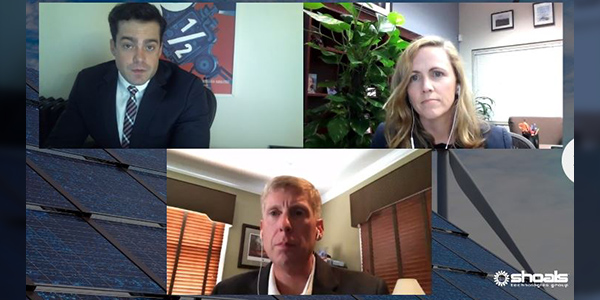NYISO and PJM officials discussed potential directions for their capacity markets and ways renewable energy producers could benefit from new market structures during a quick panel discussion during Greentech Media’s annual Power and Renewables Summit on Tuesday.
The panel featured questions about projected capacity market updates and their impact on prices, technologies and risk.
Moderator Anthony Logan, senior analyst with Wood Mackenzie, said recent NYISO BSM Mitigation Ruling Sparks Glick Rebuke.)
Logan said there will be “casualties” as a result of the orders, pointing out the burgeoning offshore wind sector in both grid operators’ markets. He also said they have sent state policymakers questioning their roles in creating their own energy mixes through legislation. He asked how NYISO and PJM have been working with states to determine what is appropriate bidding behavior by subsidized generators.
Emilie Nelson, executive vice president of NYISO, said the ISO experiences less complications when looking at policies because it only has to deal with one state government, one governor and one legislature. She said one of the benefits of a single-state grid operator is “clarity” in the environmental goals.
Nelson pointed to the Climate Leadership and Community Protection Act (CLCPA) signed by New York Gov. Andrew Cuomo in July 2019 that set ambitious clean energy goals: 100% zero-emission electricity by 2040 and an 85% cut in emissions by 2050 from 1990. It also requires 70% of renewable energy production by 2030. (See ‘Astonishing’ Buildout Needed for Clean NY Grid.)
“Having the clarity on the direction that New York is trying to go allows us to contemplate some design approaches and different ideas to move ahead and explore things not quite as mainstream to see if they would work for our state,” Nelson said.
Stu Bresler, senior vice president of market services for PJM, said the RTO differs from NYISO in that it must balance the interests of 14 jurisdictions, including D.C., instead of just one state. He said the diversity of opinions and policy direction among the states in the PJM region is a constant challenge.
But Bresler also said having each jurisdiction’s unique perspective is a valuable tool, giving PJM better insight into potential solutions to problems. The Organization of PJM States Inc. allows for an exchange of ideas as to how the markets should evolve and how operations can be done more effectively.
“That diversity of thought provides for a much richer discussion in our region and has really helped us and assisted us in evolving our operations planning and markets over the years that has been beneficial for ratepayers and consumers,” Bresler said.
Looking for Solutions
Logan said NYISO has taken a “damn the torpedoes” leadership style when it comes to decarbonization. He asked where Nelson sees the ISO’s resource mix heading under the new BSM regulations.
Nelson said NYISO is going see a rapid transformation as more solar, offshore wind and storage come online. The ISO is considering how markets need to change to accommodate the changes. She noted its Grid in Transition initiative, which focuses in part on ensuring that ancillary service products are aligned with reliability needs, particularly around New York City. (See NYISO Moves Forward on EAS Projects.)
“It’s a multifaceted strategy across our market platforms because we are expecting so much change on the system,” Nelson said.
Turning to Bresler, Logan said it appeared that PJM has taken a “wait it out” approach toward the MOPR, as some of its states debate using a fixed resource requirement (FRR). He asked how carbon pricing fits into the RTO’s markets. (See Commenters Weigh in on PJM MOPR Compliance Filing.)
Bresler said it’s PJM’s hope that states would not elect the FRR option and instead see how things “play out” in the upcoming capacity auctions. He said the “prevailing wisdom” is the MOPR won’t have a huge impact on the first few capacity auctions because of exemptions granted by FERC to existing renewable resources.
In the long term, Bresler said, PJM has questions about the sustainability and durability of the “broad MOPR rule” and wants the states to work with the RTO to achieve environmental goals by leveraging the competitive nature of the markets. (See NJ Regulators Weighing Input on Capacity Market Exit.) He said a carbon price is a potential solution to reach reduction goals, among other concepts.
“Perhaps there’s a way to incorporate other goals as well but maintain as much as we can this competitive approach across a large region, which has shown to be tremendously beneficial,” Bresler said.




